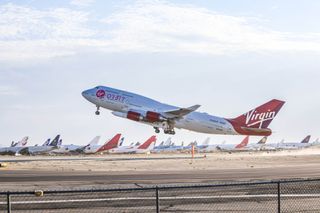
Andersen Air Force Base sits at the northern tip of the isle of Guam, amidst the western half of the Pacific Ocean. While the base has been a U.S. military outpost for decades, soon it could be a new launch site for the commercial rocket provider Virgin Orbit.
The U.S. Federal Aviation Administration (FAA) has completed an environmental review that's brought Virgin Orbit a step closer to using the runways of Andersen Air Force Base to stage future launches of small satellites using its LauncherOne rocket.
"Virgin Orbit proposes to conduct a maximum of 25 launches over the next five years (2021-2025) to place small satellites into a variety of low earth orbits," FAA officials wrote in a statement. "The completion of the environmental review process does not guarantee the FAA will issue a launch license to Virgin Orbit."
Related: Virgin Orbit gearing up for autumn launch and a busy 2022
Established in 2017, Virgin Orbit is a satellite-launching spinoff to the space tourism company Virgin Galactic founded by British billionaire Richard Branson. While Virgin Galactic aims to fly passengers to suborbital space on an air-launched SpaceShipTwo space plane, such as July's Unity 22 flight, Virgin Orbit is focused on launching small satellites, particularly cubesats, into orbit.
Currently, Virgin Orbit launches those flights from a modified Boeing 747-400 that it calls "Cosmic Girl," with the two-stage LauncherOne booster tucked under its carrier plane. When Cosmic Girl is in mid-flight, LauncherOne takes off into orbit. Virgin Orbit first succeeded in January. The company has said its setup means Virgin Orbit can launch satellites from any runway that can handle Boeing 747s.
So far, Virgin Orbit has been launching from the Mojave Air and Space Port, located in the California desert about an hour-and-a-half drive north of Los Angeles. But the company has been seeking to expand their operations to other parts of the globe.
Get the Space.com Newsletter
Breaking space news, the latest updates on rocket launches, skywatching events and more!

It has signed an agreement to bring launches to Cornwall Airport Newquay in the southwest corner of England, and Brazil’s space agency selected the company to operate from the Alcântara Space Center along that country's equatorial northern coast. Last week, Virgin Orbit announced plans to go public through a merger with a special purpose acquisition company (SPAC) called NextGen Acquisition Corp. II.
With the FAA's announcement, Guam comes one step closer to joining Virgin Orbit's launch site. The FAA's clearance states that the will have minimal environmental impact, but it's not a guarantee that Virgin Orbit will be able to launch from the middle of the Pacific.
The company will still have to clear another set of reviews to show it can operate flights from the Andersen Air Force Base safely and financially responsibly, according to the FAA.
Follow us on Twitter @Spacedotcom or Facebook.
Join our Space Forums to keep talking space on the latest missions, night sky and more! And if you have a news tip, correction or comment, let us know at: community@space.com.

Rahul Rao is a graduate of New York University's SHERP and a freelance science writer, regularly covering physics, space, and infrastructure. His work has appeared in Gizmodo, Popular Science, Inverse, IEEE Spectrum, and Continuum. He enjoys riding trains for fun, and he has seen every surviving episode of Doctor Who. He holds a masters degree in science writing from New York University's Science, Health and Environmental Reporting Program (SHERP) and earned a bachelors degree from Vanderbilt University, where he studied English and physics.
